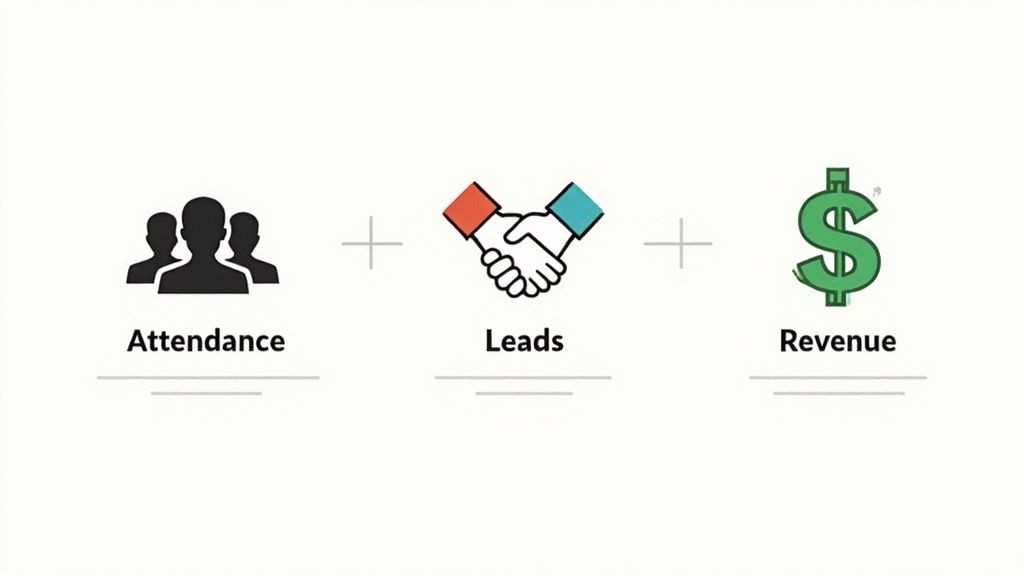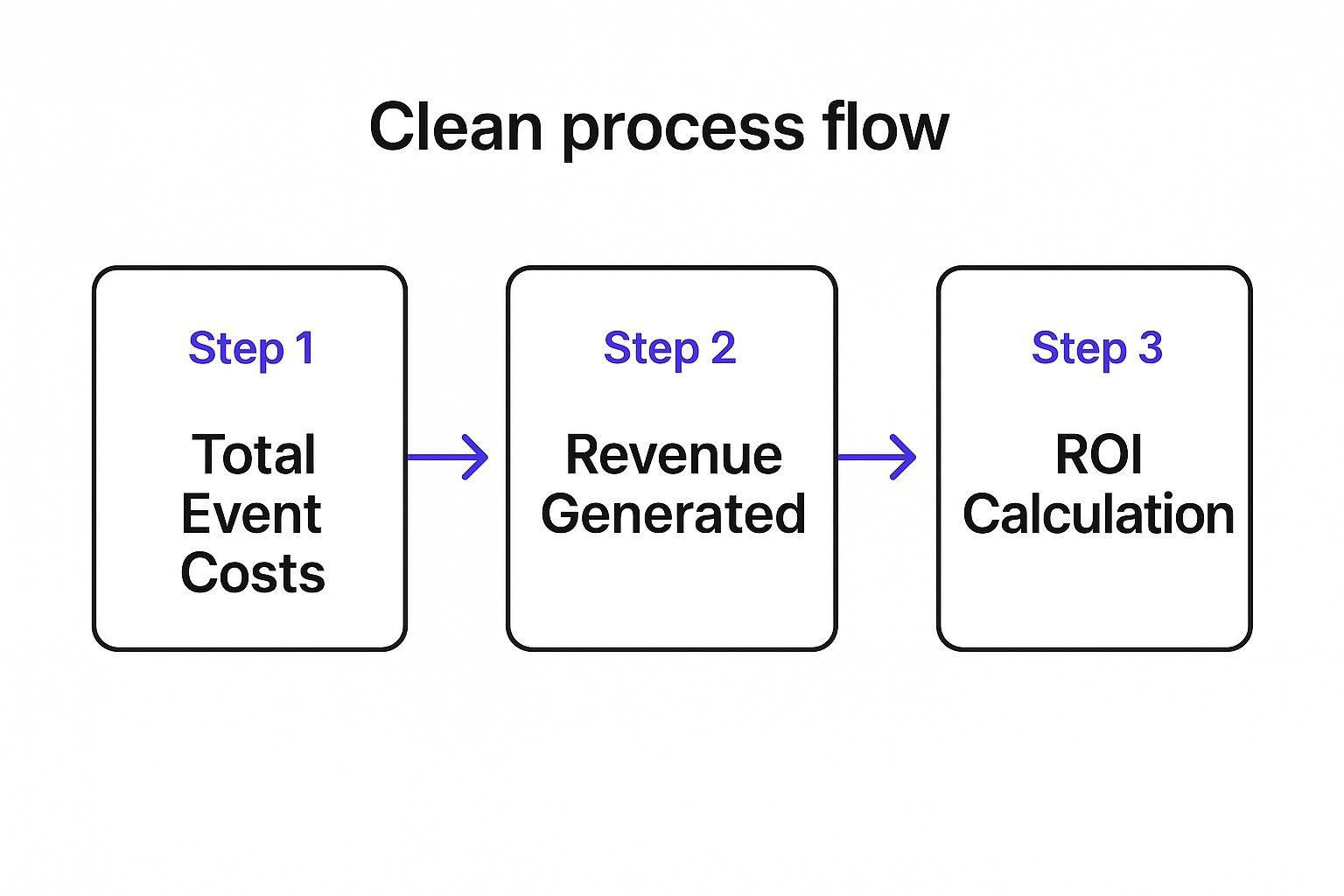Calculating your event marketing ROI used to be a "nice-to-have" metric. Now, it's a core business requirement. It’s simply the process of measuring the financial return of an event against what you spent, giving you clear, hard proof of its value to the company's bottom line.
Why Proving Event ROI Is No Longer Optional
In today's world, every single dollar of the marketing budget is under a microscope. Gone are the days of justifying a conference or webinar with a few feel-good stories and a pat on the back. Leadership teams and CFOs don't see events as just marketing expenses anymore - they're high-stakes investments that demand a quantifiable return.
The whole conversation has shifted. It's no longer, "Did we have a good event?" It's now, "What business did this event actually generate?" This puts a ton of pressure on us marketers to connect what we do directly to revenue. Without a solid way to measure event marketing ROI, your budget is on the line.
The Problem with Vanity Metrics
One of the biggest traps I see marketers fall into is leaning on "vanity metrics." These are those surface-level numbers that look great on a slide but don't tell the real story of business impact.
You know the ones I'm talking about:
- Footfall: So, a thousand people walked past your booth. How many were actually qualified leads versus people just grabbing free pens? The number alone tells you nothing.
- Social Impressions: Getting a lot of buzz is great, but impressions don't automatically lead to new customers or a bigger pipeline.
- Booth Scans: A long list of scanned badges is just that - a list. It says zero about the quality of the conversations or the potential for those contacts to turn into sales.
These metrics just don't have the context you need to make smart decisions. They won't help you figure out which parts of your event really worked or where to put your money next time for better results.
The crucial shift is from measuring activity to measuring outcomes. Proving that your event directly influenced sales pipeline, accelerated deals, or increased customer loyalty is what secures future investment.
This disconnect between activity and outcomes is a huge issue across the industry. Event marketing ROI is the critical metric for both marketers and executives, dictating future budgets. Yet, a shocking 64% of event marketers still find it hard to prove ROI, and 58% are stuck using flimsy metrics like footfall instead of focusing on real outcomes. You can dig into these stats more on how to calculate event marketing ROI.
The Strategic Imperative
Let's be blunt: failing to show a clear return on your event investment has real consequences. When budget season rolls around, the programs with fuzzy, unproven ROI are the very first to get cut. It’s that simple.
On the flip side, the teams that walk into those meetings with a clear, data-backed case for their events are the ones who not only keep their funding but also earn a strategic seat at the leadership table.
Calculating event marketing ROI isn't just about justifying what you've already spent. It's about building a predictable, repeatable engine for growth. It empowers you to make smarter decisions, fine-tune your strategy, and prove - once and for all - that events are a vital driver of your company's success.
Defining Your Event Goals and Key Metrics

Before you even think about calculating your return, you have to define what a "return" actually means for your specific event. Trying to measure event marketing ROI without clear goals is like starting a road trip without a destination - you’ll burn a lot of fuel but have no idea if you’ve arrived.
This is where a lot of marketing teams stumble. They jump straight to the logistics and promotion, completely skipping the most critical question: What are we trying to achieve, and how will we know if we’ve succeeded? A win for a B2B tech conference looks completely different from a win for a B2C product launch party.
Defining success isn't just about picking a number out of thin air. It's about making sure every part of your event - from the content to the guest list - is pulling in the same direction as your company's broader business objectives. This is how you turn a simple event into a strategic investment.
Aligning Goals with Business Outcomes
A powerful event goal directly supports a core business need. You have to move beyond generic targets like "generate buzz" and get really specific. Are you trying to shorten the sales cycle? Boost customer loyalty? Or maybe generate a precise number of high-quality leads for a new product?
Your goal dictates the metrics you absolutely must track. The event marketing landscape shows that while spending is up, success is measured very differently depending on the audience. For B2B events, lead generation is the top goal for 61–66% of marketers. On the flip side, B2C events lean heavily toward brand awareness, a priority for 62%. Some of the most-watched metrics across the board include registrations (54%), leads (53%), and attendance (40%), which really highlights the need for clear, measurable targets. You can dig deeper into these trends and what drives event marketing success on thunderbit.com.
The key is to translate those big-picture business objectives into tangible event outcomes.
- Business Goal: Increase market share in the enterprise sector.
- Event Goal: Generate 150 Marketing Qualified Leads (MQLs) from Fortune 500 companies.
- Business Goal: Improve customer loyalty and reduce churn.
- Event Goal: Achieve an 85% satisfaction score from existing customers attending our user conference.
This tight alignment makes your ROI calculation so much more powerful because you're measuring against outcomes your leadership team genuinely cares about.
Translating Goals into Key Performance Indicators
Once your primary goals are locked in, the next move is to break them down into specific Key Performance Indicators (KPIs). These are the individual data points you’ll be tracking to measure your progress. Think of your goal as the destination and your KPIs as the mile markers along the way.
For instance, if your goal is to accelerate the sales pipeline, your KPIs won't just be about lead counts. You'll want to track metrics that actually show movement and value.
A classic mistake is trying to track everything. Focus on a handful of primary indicators that directly reflect your main goal, then back them up with a few secondary metrics for extra context. This keeps your analysis sharp and actionable.
Matching Event Goals to Key Performance Indicators
Having a clear, documented link between your objectives and your metrics is non-negotiable for proving event marketing ROI. The table below is a practical guide to help you connect different goals to specific, trackable KPIs for both B2B and B2C scenarios.
| Event Goal | Primary KPI | Secondary KPIs | Example Scenario |
|---|---|---|---|
| Lead Generation (B2B) | Number of Marketing Qualified Leads (MQLs) | Cost per Lead, Booth Demos Scheduled, Sales Pipeline Influenced | A software company aims to generate 200 MQLs from their trade show booth to fuel the Q3 sales pipeline. |
| Brand Awareness (B2C) | Social Media Mentions & Reach | Media Impressions, Website Traffic Lift, Post-Event Brand Recall Survey | A new beverage brand hosts a launch party to generate 1M social impressions and a 25% lift in web traffic. |
| Customer Engagement | Session Attendance Rate | Net Promoter Score (NPS), Product Feature Adoption, Customer Satisfaction Score | A SaaS company's user conference goal is a 70% average session attendance and an NPS score above 50. |
| Sales Acceleration | Deals Closed On-Site or Within 30 Days | Sales Cycle Length for Attendees vs. Non-Attendees, Upsell/Cross-sell Revenue | An enterprise hardware vendor wants to close $500k in new business from leads met at an exclusive executive dinner. |
By establishing this framework before your event even begins, you're essentially creating a roadmap for success. You'll know exactly what data you need to collect, how to analyze it, and most importantly, how to tell a compelling story about your event's ROI to your stakeholders.
The Complete Formula for Calculating Event ROI
So, you want to calculate your event's ROI. It all boils down to a single, powerful formula. But don't let its simplicity fool you. The real magic - and the accuracy of your final number - depends entirely on how meticulously you track your total investment against the total return.
Here's the core calculation we'll be working with:
Event ROI (%) = (Total Event Revenue - Total Event Costs) / Total Event Costs x 100
A positive percentage? You’re in the black. A negative one means you've got a loss on your hands. The real work, though, isn't just plugging in numbers. It's about hunting down every single cost and every stream of revenue. Miss just one, and you could get a completely skewed picture of how your event actually performed.
To put it in perspective, think of it as a three-part journey.

First, you have to get a full accounting of your costs. Then, you connect those event activities to actual revenue. Only then can you bring it all together with the final formula for a credible ROI.
Identifying Every Single Event Cost
This is where most marketers trip up. It’s easy to underestimate your total investment when you only focus on the big, obvious invoices like the venue or catering. But the hidden and indirect costs pile up fast, and if you ignore them, you're just artificially inflating your ROI.
To avoid this, start by categorizing your expenses. I find it helpful to think in terms of "hard costs" and "soft costs."
Hard Costs (Direct Expenses): These are the tangible, out-of-pocket expenses that are usually the easiest to track.
- Venue & A/V: The room rental, projectors, mics, Wi-Fi, and any on-site tech support.
- Marketing & Promotion: Your ad spend, email platform fees, any graphic design work, and printing for flyers or signs.
- Food & Beverage: The catering bill, coffee service, and any happy hour tabs.
- Speakers & Entertainment: Fees for your keynote, plus their travel and hotel.
- Technology: The cost of your event management software, registration platform, or lead capture tools.
- Swag & Materials: T-shirts, tote bags, printed agendas - all of it adds up.
Soft Costs (Indirect Expenses): These internal costs are a bit trickier to quantify but are just as crucial for an honest calculation.
- Staff Time: This is the big one people miss. Calculate the hourly wages for your marketing, sales, and support staff for all the time they spend on planning, executing, and following up on the event.
- Travel & Expenses: Your own team’s flights, hotels, and daily expenses.
- Sales Team Time: What’s the opportunity cost of pulling your reps off the phones and putting them on the event floor?
My advice? Create a dedicated spreadsheet from day one. Log every single expense, no matter how small. Assign it to a category and be religious about updating it from the first planning meeting until the last post-event debrief. It's the only way to get a true cost picture.
To help you get started, I've put together a comprehensive checklist. Think of it as your safety net to ensure no expense slips through the cracks, giving you a rock-solid foundation for your ROI calculation.
Comprehensive Event Cost Checklist
| Cost Category | Specific Expense Examples | Tracking Method |
|---|---|---|
| Venue & Logistics | Rental fees, security, insurance, permits, cleaning services | Invoices, contracts |
| Technology | Event management software, registration platform, virtual platform fees, lead scanning app | Subscription receipts, software invoices |
| Marketing & Promotion | Digital ad spend, social media campaigns, PR agency fees, graphic design, content creation | Ad platform reports, agency invoices, freelancer contracts |
| Staffing & Personnel | Staff salaries (pro-rated), temporary staff wages, volunteer expenses, speaker fees | Payroll records, time-tracking software, speaker contracts |
| Food & Beverage | Catering per head, bar service, coffee/snack breaks, staff meals | Catering invoices, receipts |
| Materials & Swag | Printing (badges, agendas), signage, booth design/construction, promotional items | Vendor invoices, purchase orders |
| Travel & Accommodation | Staff/speaker flights, hotels, ground transportation, per diems | Expense reports, corporate travel logs |
This table isn't just a list; it's a framework for accountability. By diligently tracking these items using the suggested methods, you move from guesswork to data-driven analysis.
Attributing Revenue Accurately
Now for the other side of the coin: revenue. This can be more complex than tallying costs, especially if you have a long sales cycle. You absolutely need a system to connect a handshake at your booth to a signed contract six months later.
Your CRM is your best friend here. No question.
Set up a specific campaign in your CRM for the event before it starts. Every lead you generate or even just talk to should be tagged with this campaign. This creates a clear digital breadcrumb trail, allowing you to track their entire journey from that first interaction to a closed deal.
Here’s how I break down the different revenue streams:
- Direct Sales: This is the low-hanging fruit. It includes any deals closed at the event or from sales tied directly to an event-specific offer.
- Lead Value: Not every lead is ready to buy on the spot. To account for future potential, assign a monetary value to each Marketing Qualified Lead (MQL). You can base this on your historical lead-to-customer conversion rate multiplied by the average lifetime value (LTV) of a new customer.
- Pipeline Influence: For B2B events, a huge win is speeding up existing deals. Check your CRM: did attending your event shorten the sales cycle for prospects who were already in your funnel? That’s real, measurable value.
The precision of your revenue attribution is tied directly to how well you can monitor who actually showed up and what they did. For a deeper dive, our guide on effective event attendance tracking lays out practical ways to connect presence with pipeline.
Beyond Direct Revenue
Remember, not all returns fit neatly on a spreadsheet. For brand awareness events, you can assign value to non-financial gains. For instance, calculate the Earned Media Value (EMV) of press mentions you received or the equivalent ad spend for all the social media impressions. While not "hard" revenue, folding these figures in gives you a more holistic view of the total value your event delivered.
How Virtual and Hybrid Events Maximize ROI

The move towards digital and blended events has done a lot more than just change how we meet. It's completely rewritten the rulebook for event marketing ROI. Virtual and hybrid events aren't just a Plan B anymore; they're powerful, strategic tools for cutting costs while amplifying results.
When you ditch the geographical and physical chains of a traditional conference, you unlock a whole new level of efficiency and reach. Honestly, this opens the door to a much healthier ROI calculation before your event even kicks off.
Drastically Reduced Operational Costs
One of the first and most obvious wins with virtual or hybrid events is the massive cut in overhead. Just think about the biggest budget-eaters for an in-person event: venue rental, catering, armies of on-site staff, and flying in your team and speakers. A fully virtual event wipes most of those costs right off the books.
Even with a hybrid event, those costs are still there, but you can shrink them dramatically. You might book a much smaller, more intimate venue for your in-person crowd while serving a massive audience online. This cost-saving alone gives the "Total Event Costs" part of your ROI formula a huge head start.
The numbers don't lie. We've seen that, on average, virtual events can cost 75% less than their in-person-only counterparts. This is a huge reason why 81% of companies report a higher ROI from their online formats.
Unprecedented Global Reach and Scalability
An in-person event is always going to be capped by the size of the room and how much your attendees can spend on travel. A virtual event, on the other hand? The sky's the limit. Your audience is no longer just one city or region; it's the entire globe. This directly feeds a core business goal for most of us: market penetration.
This massive expansion of your potential audience has a few fantastic knock-on effects for your event marketing ROI:
- More Registrations and Attendees: When people don't have to worry about flights and hotels, your top-of-funnel numbers get a serious boost.
- Better Lead Generation: A bigger, more diverse audience pool simply means more chances to capture high-quality leads.
- Greater Brand Exposure: Your event and its core message can suddenly land in new markets you might never have reached before.
The industry data is shouting this from the rooftops. The virtual event market is on track to hit $236.69 billion, with 63% of organizers planning to invest even more. Why? Because these events can boost lead capture by up to 30%, creating a much more direct line to revenue. You can dig into more of these eye-opening event industry statistics at Remo.co.
Superior Data Collection and Attendee Insights
While in-person events often rely on simple badge scans and headcount estimates, digital platforms are an absolute goldmine of behavioral data. This is where virtual and hybrid models truly pull ahead, giving you the kind of granular insights that make your event marketing ROI not just a number, but a strategic weapon.
Every single click, view, and chat message can be tracked. You get a crystal-clear picture of what your audience actually cared about.
Key Data Points You Can't Live Without:
| Data Point | What It Tells You | How It Boosts ROI |
|---|---|---|
| Session Dwell Time | Which topics and speakers really held your audience's attention. | Helps you double down on winning content for future events, attracting even better leads. |
| Polls & Q&A Participation | The specific questions and pain points of your most engaged attendees. | Gives your sales team incredible intelligence for more relevant follow-up conversations. |
| Resource Downloads | Who is showing serious buying intent by grabbing case studies or whitepapers. | Pinpoints your "hot leads" who are ready for an immediate, personalized call from sales. |
This firehose of rich data lets you do incredibly precise lead scoring and segmentation. Instead of just dumping a list of names on your sales team, you can hand them a prioritized list of genuinely engaged prospects, complete with notes on what they're interested in. This shortens the sales cycle and drives up conversion rates, directly pumping up the "Total Event Revenue" side of your ROI calculation. It's all about a smarter, faster follow-up process that turns fleeting engagement into real, measurable business.
Essential Tools for Automating ROI Tracking
Let’s be honest: if you're still wrestling with spreadsheets to measure event ROI, you're setting yourself up for a world of pain. Manual data entry isn't just slow; it's a breeding ground for tiny errors that can completely torpedo your calculations. It's time to ditch the tedious work and build a tech stack that does the heavy lifting for you.
When you connect the right platforms, you create a seamless pipeline for your data. What was once a jumbled mess of information becomes a real-time dashboard of your event's performance. This shift allows you to make quick, data-backed decisions that actually move the needle on your bottom line.
The CRM as Your Central Hub
Think of your Customer Relationship Management (CRM) platform - like a HubSpot or Salesforce - as the sun in your event ROI solar system. Everything should revolve around it. This is where all your lead and customer data lives, making it the perfect place to connect what happens at an event with actual business results.
Here’s the non-negotiable first step: create a dedicated campaign in your CRM for every single event. Every lead, whether they came from a registration form, a booth scanner, or a post-event survey, has to be tagged with that specific campaign. This creates a clear digital breadcrumb trail.
Without that trail, attributing revenue is just a guessing game. With it, you can follow a contact's journey from their first interaction at your event all the way to a closed-won deal months down the line. This is how you prove long-term value.
Event Management Platforms
Modern event management platforms like Cvent or Bizzabo are so much more than just registration pages. They are powerful data collection machines that automate a ton of the grunt work involved in tracking costs and engagement.
These platforms manage the whole shebang, from building a branded event site and handling ticketing to sending out automated emails. That centralization is a game-changer.
Here's where they really shine for ROI tracking:
- Integrated Registration: Attendee data is automatically synced straight into your CRM, tagging them with the correct event campaign right from the get-go.
- Engagement Tracking: For virtual or hybrid events, these tools capture priceless data - which sessions people attended, how long they stayed, what resources they downloaded. All of it.
- Cost Management: Many platforms even have features to help you log expenses, giving you a much cleaner view of your total investment.
By using a dedicated event platform, you stop juggling dozens of disconnected tools. This massively cuts down the risk of data getting lost or misinterpreted along the way.
A common mistake I see is people treating their event platform like a silo. The real magic happens with tight integration. When your event platform "talks" to your CRM, you get a 360-degree view of attendee behavior and its impact on your sales pipeline.
Marketing Automation and Post-Event Follow-Up
The window right after your event is critical. It’s often where potential revenue is either won or lost. A fast, relevant follow-up makes all the difference, and this is where marketing automation tools are your best friend. These systems let you nurture leads based on what they actually did.
Imagine these scenarios playing out automatically:
- An attendee drops by your demo booth. That action triggers a workflow that immediately assigns them to a sales rep for a personalized call.
- A prospect sat through a technical deep-dive session. They automatically get an email with the session recording and a related case study.
- Someone registered but was a no-show. They’re dropped into a separate nurture sequence with a "sorry we missed you" message and an invite to a future webinar.
Trying to pull this off manually at scale is nearly impossible. If you want to dive deeper, exploring the concepts in a guide to event marketing automation can unlock even more ways to streamline these workflows and make sure no lead ever falls through the cracks.
Tying It All Together for a Cohesive View
The end goal here is an interconnected tech stack where data flows freely between systems. This creates a closed-loop reporting system that makes calculating event marketing ROI surprisingly straightforward.
A typical integrated workflow looks something like this:
| Step | Action | Tool Used | Outcome |
|---|---|---|---|
| 1. Promotion | A prospect registers for your event. | Event Management Platform | Attendee data is captured and sent to the CRM. |
| 2. Engagement | The attendee joins a session and downloads a whitepaper. | Virtual Event Platform | Engagement data is recorded and synced to their CRM profile. |
| 3. Nurture | The attendee receives a targeted follow-up email. | Marketing Automation Tool | Lead is nurtured based on demonstrated interests. |
| 4. Conversion | The prospect requests a demo and becomes a customer. | CRM | The deal is marked "closed-won" and attributed to the event campaign. |
This automated chain of custody provides an undeniable link between your event activities and the revenue they generate. It eliminates the guesswork and gives you the hard data you need to prove your event's worth and secure that budget for next year.
Frequently Asked Questions About Event Marketing ROI
Even with a rock-solid plan, you’re bound to hit some tricky questions when calculating event ROI. This is where I see a lot of marketers get bogged down, especially when they need to justify an event that doesn't have a clear, immediate sales goal.
Let’s walk through some of the most common hurdles you'll probably face.
How Do I Measure The ROI Of A Brand Awareness Event?
This is the big one. When your main goal is building brand love instead of closing deals on the showroom floor, the standard ROI formula feels like trying to fit a square peg in a round hole. It just doesn't work.
The secret is to shift your thinking away from direct revenue and focus on what I call "brand value metrics."
Instead of hunting for sales figures, you need to track the signs that your brand's presence and perception actually grew because of the event. Things like:
- Social Media Analytics: Keep an eye on the volume of mentions, your engagement rates, and the overall reach during and right after your event. Seeing a 30% spike in positive mentions? That's a powerful result you can take to the bank.
- Website Traffic: Did you see a noticeable jump in direct and organic traffic to your website? That's a clear signal your event sparked curiosity and got people to take the next step.
- Earned Media Value (EMV): Tally up every press clipping, blog feature, or influencer shoutout you got. Then, you can assign a real dollar value to that coverage based on what it would have cost to buy that same exposure through advertising.
- Post-Event Surveys: This one is simple but effective. Just ask attendees about how they see your brand. A quick pre- and post-event survey can show a measurable shift in brand sentiment or recall.
By putting a financial equivalent on these outcomes, you can build a really compelling case for the event's value, even without a single direct sale to point to.
What Is A Good Benchmark For Event Marketing ROI?
I wish I could give you a single magic number here, but the truth is, a "good" event marketing ROI really depends on your industry, the type of event, and what you’re trying to achieve. The benchmarks for a B2C music festival are going to be worlds apart from a B2B software conference.
That said, a widely accepted target many experienced marketers aim for is a 3:1 to 5:1 return. That works out to an ROI of 300% to 500%. For every dollar you put in, you’re getting three to five dollars back. Not bad at all.
But honestly, the most important benchmark is your own. The real goal is to get better over time. Establish your baseline with your first properly tracked event, and then make it your mission to beat that number with every single event that follows.
For events focused on generating leads, I often find that Cost Per Lead (CPL) is a more telling metric. How does your event's CPL compare to your other marketing channels, like paid search ads or content syndication? If your event is bringing in higher-quality leads for a similar cost, that’s a massive win you can proudly share with your leadership team.
How Soon After An Event Should I Calculate ROI?
Calculating your event ROI isn't a task you just check off the list the week after everyone goes home. It’s really a multi-stage process.
You'll want to do an initial calculation within one to two weeks after the event wraps up. This first look is all about capturing the immediate impact - things like sales made right there on the floor or leads who requested a demo on the spot.
But the real story of your event's success takes time to unfold. The true value often shows up months later as leads from the event slowly work their way through your sales funnel. A contact who seemed lukewarm at the event might suddenly become a red-hot prospect three months down the line after nurturing them with your follow-up content.
For the full picture, you need to re-evaluate your ROI at a few key moments. I usually recommend this rhythm:
- Initial Check-in (2 Weeks): Capture the immediate wins and get a feel for initial lead quality.
- Mid-Funnel Review (3-6 Months): Now you can see how many of those event leads have become sales-qualified and are actively in the pipeline.
- Long-Term Analysis (12 Months): This is where you assess final conversion rates and calculate the total revenue and customer lifetime value (LTV) that came from your event attendees.
This long-term view is absolutely critical for proving the full, lasting impact of your event marketing. It also gives you incredible insights for your next event. For example, high attendance is great, but you can learn even more by diving into our guide on strategies to increase event attendance and then tracking how those new attendees convert over the full 12-month cycle.
Ready to take control of your event promotion and simplify the attendee experience? Add to Calendar PRO gives you the tools to create beautiful, reliable Add to Calendar buttons, manage RSVPs, and automatically generate SEO-friendly event pages. Stop leaving attendance to chance and start boosting your event marketing ROI today. Explore Add to Calendar PRO.



